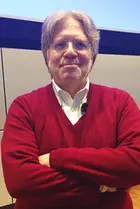
Making the Perfect Pitch
Angel investor David Rose YC ’80 listens to more than 1,000 pitches each year from entrepreneurs seeking funding. He has heard, he says, “the good, the bad, and the disastrous.”

A serial entrepreneur himself, Rose discussed the art of the pitch with Yale Entrepreneurial Institute summer fellows and other entrepreneurs at Yale SOM on June 2. Rose is the founder and CEO of Gust, an online platform connecting entrepreneurs and investors in more than 100 countries; the founder and chairman emeritus of New York Angels, New York City’s largest angel investing group; and the managing partner of Rose Tech Ventures, an early-stage investment fund dedicated to launching new ventures.
The best pitches, Rose says, follow the “K.R.S.P.” framework:
K: “The K stands for knowledge. You can only pitch what you know. Looking for an investor isn’t acting on stage; it isn’t scamming somebody. You are trying to get money from somebody who is going to invest in you and be your partner for the very long term, and therefore knowledge talks and bullshit walks. If you don’t know what you’re talking about, save everybody the trouble and don’t present… You’ve got to know your product and your market and really believe in it. Then you’ve got to be able to go out and explain what you know.”
R: “Respect is a really critical part of giving a presentation. It’s two kinds of respect, because there are two people you’re got to respect here, the first of whom is you.… An investor cannot invest unless they have somebody to invest in, so they need you as much as you need them. Without you, they wouldn’t exist. You are coming into them really as a peer. You are on equal footing. You’re just playing different roles.
The other person you’ve got to respect is your audience, and that’s really important. Even if your audience doesn’t know what you know about your business, they know other things and they may have more experience, so you have to have real respect for the people you’re pitching.”
S: “The S stands for skill, because you can actually learn how to pitch. There are some great books you can read for more information. There’s a shortened version of what I’m going to teach you today on YouTube. There’s a TED talk I’ve done on it. It’s had about a million downloads.”
P: “The P stands for preparation. You’ve got to take the time to practice, practice, practice. You should not get up there to pitch for money until you have done your presentation 20 times in front of a live audience. It can be your team members. It can be the YEI staff. It can be your parents. It can be your classmates, your roommate. I don’t care who it is. Just do it, because every time you get up there and pitch, you’ll get more familiar with the material. You’ll understand what’s coming next, where you’re going. You’ll be gauging audience feedback and figuring out how to respond.”
